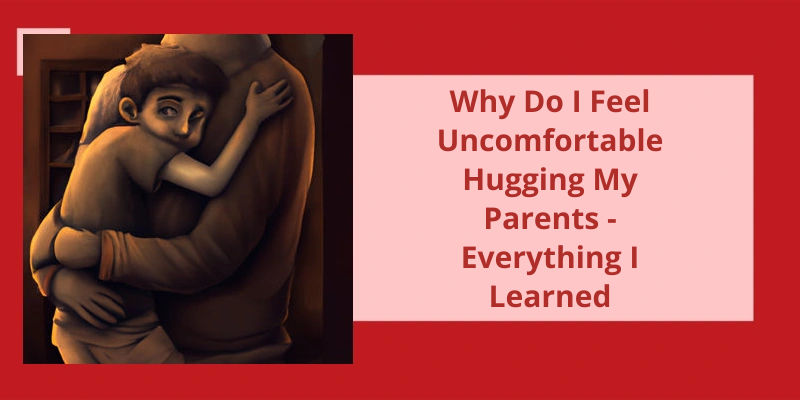In today's increasingly complex and introspective world, it isn’t uncommon for individuals to experience a range of emotions and struggles when it comes to familial relationships. One particular phenomenon that many people may find themselves grappling with is the discomfort or unease associated with hugging their own parents. This seemingly paradoxical experience often arises from a multitude of factors, including personal boundaries, past experiences, cultural influences, and psychological dynamics within the parent-child relationship. By delving into the depths of this topic, we can uncover the underlying reasons behind this discomfort and gain a deeper understanding of the complex tapestry of emotions that can shape our connections with those closest to us.
Why Am I Uncomfortable Hugging My Family?
Many factors can contribute to feeling uncomfortable hugging ones parents. One significant factor is social anxiety. This anxiety could stem from fear of judgment or rejection, making physical contact feel intimidating and uncomfortable.
Additionally, past experiences may play a role in hug avoidance. Negative experiences, such as neglect or abuse, can create a deep-rooted fear of physical contact, even within the context of a loving family. These experiences can lead to mistrust and a heightened sensitivity to touch, making hugging an uncomfortable or triggering act.
As individuals grow and develop their sense of self, they may discover that physical touch doesn’t align with their preferred way of expressing affection. Everyone has their unique way of showing love, and for some individuals, hugging may not be the most comfortable or preferred method.
Additionally, cultural and societal norms can influence comfort levels with affectionate touches. Some cultures emphasize the importance of physical closeness and hugging as a way of expressing love and respect. These cultural influences can shape individuals attitudes towards physical touch and impact their comfort levels with hugging parents.
Some individuals naturally have lower levels of physical affection or may prefer different forms of expression, such as verbal affirmations or acts of service.
It’s essential to respect individuals comfort levels and find alternative ways to express love and affection that align with their preferences and needs.
The Role of Attachment Styles in Influencing Comfort Levels With Hugging Family Members
The role of attachment styles can greatly influence an individual’s comfort level with hugging family members, including parents. Attachment styles develop in early childhood and shape how we form and maintain relationships throughout our lives.
Those with secure attachment styles typically feel comfortable and secure in their relationships, including physical affection like hugging. They’ve grown up with consistent and loving parental figures, which helps build a healthy sense of trust and safety.
On the other hand, individuals with insecure attachment styles may feel uncomfortable with hugging family members, even their parents. This can stem from various factors such as inconsistent caregiving, neglect, or abusive experiences. These negative experiences can lead to feelings of insecurity, fear, or distrust, making physical affection difficult to initiate or receive.
It’s important to understand that discomfort with hugging family members isn’t necessarily a reflection of a lack of love or affection. Instead, it may be rooted in past experiences and attachment patterns. Communication and understanding can play a crucial role in navigating these discomforts and finding alternative ways to express love and connection with parents and family members.
It can be disheartening when your daughter doesn’t seem to respond to your hugs and affectionate gestures. While she may not be naturally inclined towards touchy-feely moments, it’s important to remember that everyone has different comfort levels with physicality. However, even if she’s a more self-reliant temperament, there may still be times when she needs or appreciates a hug or kiss. By paying attention to her reactions and understanding her boundaries, you can find ways to offer your affection in ways that make her feel comfortable.
Why Does My Daughter Not Hug Me?
It can be frustrating when your daughter doesn’t seem interested in hugging you. However, it’s essential to remember that everyone has different preferences when it comes to physical affection. This doesn’t mean she loves you any less; it just means she expresses her affection differently.
Observing your daughters reactions and cues can help you determine if she’s open to receiving affection at a particular moment. For example, if shes upset or scared, she may be more receptive to a hug or a comforting touch. Pay attention to her body language, facial expressions, and verbal cues to gauge her willingness for physical contact.
One way to foster a closer bond with your daughter is by finding activities that you both enjoy and can engage in together. This can help build trust and emotional connection without relying solely on physical touch. Allow her to express her affection in her own way, whether it be through words, acts of service, or spending quality time together.
Remember that every child is unique, and it’s essential to celebrate and embrace their individuality. By respecting your daughters preferences and finding alternative means of showing affection, you can still cultivate a warm and loving relationship with her.
Nurturing Emotional Connection: Discussing Ways to Build Emotional Connection With Your Daughter Beyond Physical Affection, Such as Through Open Communication and Active Listening.
Nurturing emotional connection with your daughter involves various strategies that go beyond physical affection. One effective way is through open communication, creating a safe space for her to express her thoughts and emotions. Actively listen to her, showing genuine interest in what she’s to say. This helps you understand her perspective and build a stronger bond. By nurturing this emotional connection, you can enhance your relationship with your daughter and create a sense of comfort and trust.
Conclusion
This discomfort may be influenced by cultural differences, personal boundaries, past experiences, or unresolved emotional issues. Open communication and understanding between parents and their children are imperative to address these concerns and find alternative ways to express love and support. Ultimately, it’s important to prioritize one's emotional well-being and establish boundaries that align with personal comfort and growth.






